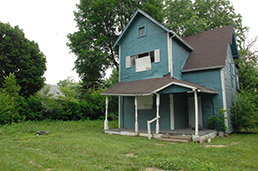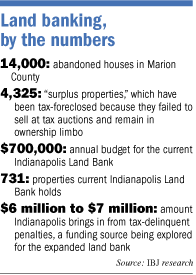Subscriber Benefit
As a subscriber you can listen to articles at work, in the car, or while you work out. Subscribe NowIndianapolis is in the early stages of expanding a practice that some urban-planning leaders see as a solution to the growing abandoned housing problem.
Land banks, which allow government agencies and not-for-profits to take over tax-foreclosed properties and put them back into productive use, have shown positive results in states such as Michigan and Ohio.
 This property at 425 N. Tacoma St. is among those in the city’s current land bank. (IBJ Photo/ Perry Reichanadter)
This property at 425 N. Tacoma St. is among those in the city’s current land bank. (IBJ Photo/ Perry Reichanadter)Now, Indiana redevelopment advocates are pursuing broader use of land banks and the legislative changes needed to carry it out in Indianapolis, as well as other communities across the state.
In Indianapolis, a group led by longtime affordable housing developer Frank Hagaman and urban policy consultant Gina Radice have formed a not-for-profit Land Bank of Indianapolis. The group has a board, and once its 501(c)3 status is finalized, its members can start raising private funds and seeking grants to operate.
Hagaman and Radice are in talks with city officials about contracting with the city to add capacity to Indianapolis’ existing land bank, which has just two staff members and an annual budget of $700,000 for things such as property acquisition, maintenance costs and demolition.
The existing land bank holds about 731 properties—a small fraction of the estimated 14,000 abandoned and vacant properties across Marion County. It has put about 135 properties back into productive use since launching in 2007.
The larger goal, land bank leaders say, is to use the not-for-profit as a building block for creating a widely expanded land bank with a bigger revenue stream. The land bank’s current funding sources—a federal grant program and fees paid by code violators for issues such as high weeds and grass—are expected to run out at the end of 2012, so the city must find a replacement.
That could potentially include penalty fees on delinquent tax payments, which would bring in $6 million to $7 million per year, according to estimates by the Marion County Treasurer’s Office.
A more robust land bank also would have broader powers to assemble and dispose of properties for uses such as big commercial developments.
“This really is about property values,” Hagaman said. “If you’re eliminating blight and doing appropriate community redevelopment through the land bank, the byproduct is, you’ve increased property values.”
Officials in the Mayor’s Office and the city’s Department of Metropolitan Development have expressed support for the concept.
Getting it off the ground, though, will require carefully navigating how local dollars are distributed at a time they are particularly scarce.
For example, using penalty fees to fund the land bank would divert that revenue from taxing units, which currently get a share proportionate to their distribution of other tax revenue. Some local officials question whether that’s wise in an era when property-tax caps limit their other funding sources.
“We see the bigger vision—it’s great, but it’s also taking revenue out of other units that have to deal with the tax caps,” said Tom Creasser, deputy Marion County treasurer. “Penalty fees are needed by other units of government.”
Adding capacity
Indianapolis created its existing land bank after the state in 2006 passed legislation governing how land banks operate.
Such organizations typically identify properties they want to acquire from tax sales—where properties are auctioned after residents miss multiple tax payments. Once they’re acquired—and the 120-day period owners have to redeem them expires—the land bank works to get those properties back on the tax rolls.
In Indianapolis, most often that involves working with not-for-profit community developers, which rehab and sell them to individual homeowners, or demolish them and sell the land to abutting homeowners or convert it into a use such as an urban garden.
The model works, but it has limitations.
 For one, not-for-profit developers operate only in some areas of the county, and because the city relies heavily on them to dispose of properties, parts of Marion County without effective community development corporations languish.
For one, not-for-profit developers operate only in some areas of the county, and because the city relies heavily on them to dispose of properties, parts of Marion County without effective community development corporations languish.
And the reach of effective not-for-profit developers could become more limited in coming years if federal funding to support their efforts becomes harder to come by.
In addition, the land bank’s small scope prevents it from touching many of the properties that go through the tax sale and some of the 4,325 so-called “surplus properties,” which already have gone through the sale but failed to get takers.
The Treasurer’s Office has been working to dispose of those properties, but its capacity also is limited.
The existing land bank, with its small annual funding amount, “is still challenged by its revenue source,” said Andy Fraizer, executive director of the Indiana Association for Community Economic Development, which is lobbying for stronger statewide land banking authority. “They’re struggling to do a land bank with two staff members, given the challenges we’re confronting.”
Other cities, including Marion, have been able to do more under the existing state law, largely because they have dedicated more time and resources to the problem.
Marion, which has a population of just 30,000, has an annual budget of $400,000 for its land banking efforts—an amount that includes demolition, property upkeep and staff time.
As a result, the city has been able to put back into use about 200 problem properties in the last two years. Its aggressive approach also has increased property-tax collection rates from about 92 percent to roughly 97 percent, said Darren Reese, the city’s director of development.
Cuyahoga County, Ohio, which includes hard-hit Cleveland and has had a robust land bank since 2009, has acquired 899 properties. Of those, the bank has demolished 267, rehabbed 119 and sold 101.
A funding question
Ohio is among the models local land-bank backers are looking to in formulating their own strategy.
In Cuyahoga County, the county doesn’t take on all the tax-foreclosed properties, but handpicks those unlikely to succeed without government intervention, said Tom Fitzpatrick, an economist with the Federal Reserve Bank of Cleveland who has studied the land bank and was in Indianapolis June 20 to talk about its efforts.
Its staff of about 20 also works closely with not-for-profit developers.
Radice, one of the leaders on the local land bank initiative, said organizers are still figuring out the best approach. But she suggested one long-term strategy could include eliminating—or scaling back the use of—the county’s tax auction.
She pointed out that speculators often buy bundles of properties in hopes of recouping interest once an owner reclaims them, but let properties that aren’t reclaimed languish.
“It has been demonstrated in Marion County and across the country that tax sales are not an effective way to reclaim properties that are vacant and abandoned and put them back into productive and tax-generating status,” Radice said.
As they develop a concrete model, land bank advocates have been traveling to communities across the state to garner support for the concept. Their plan is to push for legislation in the 2012 General Assembly.
Meanwhile, getting the not-for-profit Land Bank of Indianapolis into operation would provide a basic structure the city could use if legislation were to pass next year.
The largest hurdle likely will be establishing a funding source, which is a sticking point even for communities that have invested in the effort.
Reese, of Marion, said he thinks it should be left up to individual communities to find innovative ways to tackle the problem.
“I don’t know that we need to create a whole bunch of new organizations around the state to do it,” Reese said.
“To a small or midsize community that is worried about funding police and fire, rather than adding an organization to an already-stretched municipal budget, we need to find the most effective way to get these properties back on the tax rolls.”
Those promoting land banking say the tool is just that. By putting properties back into effective use, they say, land banks bolster the assessed value eligible for taxation and help municipalities bring in more revenue. But the process takes time.
“The land bank isn’t a silver-bullet solution,” said Fitzpatrick, the Cuyahoga County expert. “It’s a long-term process that has to be developed incrementally.”•
Please enable JavaScript to view this content.
